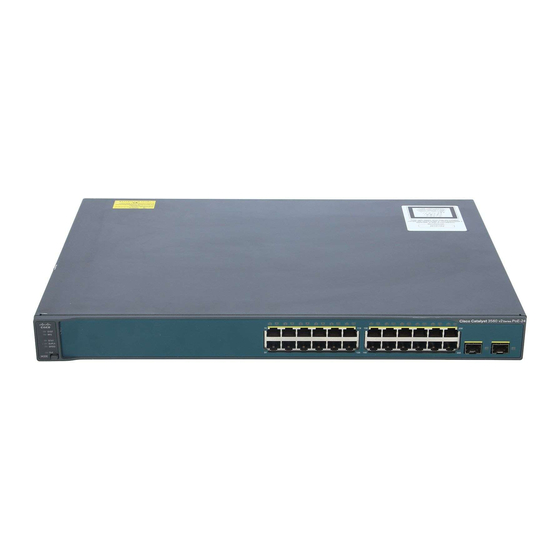- ページ 8
スイッチ Cisco 3560V2 - Catalyst 48 10/100 PoeのPDF データシートをオンラインで閲覧またはダウンロードできます。Cisco 3560V2 - Catalyst 48 10/100 Poe 20 ページ。 Cisco catalyst 3560v2-24ps: specifications

perform load balancing. Routed uplinks optimize the utility of uplinks out of the LAN Access by eliminating
unnecessary broadcast data flows into the network backbone.
Other high-performance routing features include:
Cisco Express Forwarding hardware routing architecture delivers extremely high-performance IP routing.
●
Basic IP unicast routing protocols (static, RIPv1, RIPv2, EIGRP-Stub) are supported for small-network routing
●
applications.
Advanced IP unicast routing protocols (OSPF, Interior Gateway Routing Protocol [IGRP], EIGRP, and Border
●
Gateway Protocol Version 4 [BGPv4]) are supported for load balancing and constructing scalable LANs. The
IP Services license is required.
IPv6 unicast routing capability (static, RIP, OSPF, and EIGRP protocols) forwards IPv6 traffic through
●
configured interfaces (requires the IP Services license).
Policy-Based Routing (PBR) allows superior control by enabling flow redirection regardless of the routing
●
protocol configured. The IP Services license is required.
Inter-VLAN IP routing provides for full Layer 3 routing between two or more VLANs.
●
Protocol Independent Multicast (PIM) for IP Multicast routing is supported, including PIM sparse mode (PIM-
●
SM), PIM dense mode (PIM-DM), and PIM sparse-dense mode. The IP Services license is required.
Distance Vector Multicast Routing Protocol (DVMRP) tunneling interconnects two multicast-enabled networks
●
across nonmulticast networks. The IP Services license is required.
Fallback bridging forwards non-IP traffic between two or more VLANs. The IP Services license is required.
●
Integrated Cisco IOS Software Features for Bandwidth Optimization
The Cisco Catalyst 3560 v2 series offers several advanced features for bandwidth optimization. These features
include:
Per-port broadcast, multicast, and unicast storm control prevents faulty end stations from degrading overall
●
systems performance.
IEEE 802.1d Spanning Tree Protocol support for redundant backbone connections and loop-free networks
●
simplifies network configuration and improves fault tolerance.
PVST+ allows for Layer 2 load sharing on redundant links to efficiently use the extra capacity inherent in a
●
redundant design.
IEEE 802.1s Multiple Spanning Tree Protocol (MSTP) allows a spanning-tree instance per VLAN, enabling
●
Layer 2 load sharing on redundant links.
ECR provides load balancing and redundancy.
●
VPN routing/forwarding (VRF)-Lite enables a service provider to support two or more VPNs, with overlapping
●
IP addresses.
VRF Aware IP Services enable the use of functions such as TFTP, FTP, SYSLOG, SNMP, traceroute, ping,
●
HSRP, ARP, and IP SLAs within a VRF.
Local Proxy Address Resolution Protocol (ARP) works in conjunction with Private VLAN Edge to minimize
●
broadcasts and maximize available bandwidth.
VLAN1 minimization allows VLAN1 to be disabled on any individual VLAN trunk link.
●
VLAN Trunking Protocol (VTP) pruning limits bandwidth consumption on VTP trunks by flooding broadcast
●
traffic only on trunk links required to reach the destination devices.
© 2009 Cisco Systems, Inc. All rights reserved. This document is Cisco Public Information.
Data Sheet
Page 8 of 20
